|
|
|
Sort Order |
|
|
|
Items / Page
|
|
|
|
|
|
|
| Srl | Item |
| 1 |
ID:
109937
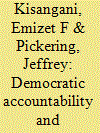

|
|
|
|
|
| Publication |
2011.
|
| Summary/Abstract |
Agreement on which democratic regime types are prone to use diversionary force has yet to materialize in the embryonic empirical literature on the subject. Nor has consensus emerged on the theoretical approach that best explains the diversionary tendencies of different democratic political systems. By separating out benevolent and belligerent diversionary military missions, we begin to offer some clarity to this mixed empirical literature. In zero-inflated Poisson estimates of fifty-six democracies from 1950 to 2004, we find compelling evidence that a theoretical framework emphasizing leader accountability best explains democratic diversionary behavior. More accountable democratic executives (leaders of majoritarian, weak-party majority, and minority governments) appear significantly more likely to use diversionary force than counterparts with less accountability (especially in coalition governments). Democratic leaders also seem to use benevolent military force for diversionary purposes more often than belligerent force, though they still use the latter in specific contexts.
|
|
|
|
|
|
|
|
|
|
|
|
|
|
|
|
| 2 |
ID:
078284


|
|
|
|
|
| Publication |
2007.
|
| Summary/Abstract |
Research on the diversionary use of force has burgeoned in recent years, but the literature remains divided. This paper attempts to reconcile extant findings by advancing a new theoretical framework for diversionary force centered on the agenda-setting literature. It expands the conventional conception of diversionary behavior and distinguishes the benevolent use of force over low politics issues (which we term socioeconomic interventions, SEI) from belligerent force used over high politics issues (which we term politico-strategic interventions, PSI). This expansion also refines our understanding of strategic conflict avoidance (SCA). Using Zero-Inflated Poisson (ZIP) regression on 140 countries from 1950 to 1996, we find that democracies and mixed regimes tend to use SEI for diversion even though strategic conflict avoidance does not prevent them from using PSI. We further find that autocracies do not externalize their internal problems with either type of armed force and that, surprisingly, strategic conflict avoidance may constrain autocracies suffering economic decline. These outcomes suggest that our theory has utility and that research on both diversion and SCA would benefit from further theoretical refinement.
|
|
|
|
|
|
|
|
|
|
|
|
|
|
|
|
| 3 |
ID:
151711


|
|
|
|
|
| Summary/Abstract |
The empirical international conflict literature has given much recent attention to interstate armed force’s impact on human well-being. While empirical research has advanced our understanding of the phenomenon considerably, we argue that one conclusion that many studies have reached is preliminary. Some recent research contends that only full-scale war, and not force short of war, has a discernable impact on human welfare or physical quality of life (PQOL). We develop theory on one type of force short of war, large-scale foreign military intervention (FMI), and its potential effects on PQOL. Using interrupted time series and panel corrected standard error methodologies, we find that from 1960 to 2005 large-scale FMI had a statistically and substantively significant impact on the PQOL of populations in 106 developing countries. The specific effect that this type of armed force has depended in large part on the regime type of the target country.
|
|
|
|
|
|
|
|
|
|
|
|
|
|
|
|
| 4 |
ID:
184650
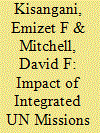

|
|
|
|
|
| Summary/Abstract |
Since the end of the Cold War, the UN has extended many of its missions in conflict zones to include political, military, and humanitarian activities. Many humanitarian nongovernmental organizations have been critical of these “integrated” UN missions, claiming that they can blur the distinction between political, military, and humanitarian action, thus placing humanitarian aid workers at risk of retaliation from warring factions opposed to the UN’s political objectives. This proposition is empirically tested using generalized methods of moments statistical analysis of sixty-seven countries that experienced intrastate conflict between 1997 and 2018. When assessing attacks in general—to include the sum of aid workers killed, wounded, and kidnapped—the results indicate that humanitarian aid workers are more likely to come under attack in countries that have an integrated UN mission. However, when the attacks are assessed separately, results show that this relationship holds only with aid workers who are killed in the field.
|
|
|
|
|
|
|
|
|
|
|
|
|
|
|
|
| 5 |
ID:
090142
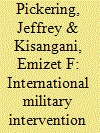

|
|
|
|
|
| Publication |
2009.
|
| Summary/Abstract |
As major wars have become uncommon over recent decades and the efficacy of economic sanctions is questioned, foreign military intervention seems to have become increasingly prevalent on the international scene. Military intervention has also gained a degree of moral legitimacy, as it is now often launched for humanitarian ends rather than simply to further the intervener's strategic or material interests. Despite the apparent increase in the use of foreign military intervention as a policy tool in recent years, the quantitative international conflict literature continues to operate without either a comprehensive or a current inventory of foreign military interventions. The authors attempt to fill this gap by updating Pearson & Baumann's International Military Intervention (IMI) dataset from 1989 to 2005. IMI has a number of attributes that should make it attractive to quantitative international conflict scholars. One is that it is one of a small handful of interstate conflict datasets that attempts to discern the motives behind state uses of force. Also, its substantive coverage is broad, allowing researchers to separate out and focus on the forms of intervention (supportive, hostile, humanitarian, territorial, etc.) that are relevant to their research. As a preliminary validity test of the updated data, the authors analyze patterns of Cold War and post-Cold War military intervention in the IMI collection to see if they correspond with conventional wisdom on real world events.
|
|
|
|
|
|
|
|
|
|
|
|
|
|
|
|
| 6 |
ID:
131009
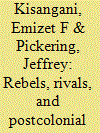

|
|
|
|
|
| Publication |
2014.
|
| Summary/Abstract |
A recent, notable strain of empirical research argues that postcolonial state-building follows a pattern similar to the European state-building experience. It acknowledges that war is less common today, but contends that interstate rivalry now drives state-building. We argue that postcolonial state-managers have little reason to build state capacity in response to rival states. There is only a slight chance that these rivalries will escalate into an existential threat for the government. Attention should instead be focused on the more tangible threat posed by transnational rebels and postcolonial governments' use of low-scale military force to combat such non-state actors. Using interrupted time series methodology on a sample of 72 countries from 1972 to 2002, we find that postcolonial state military intervention against transnational rebels increases direct taxes (a measure of state penetration) and non-tax revenue (state autonomy) collected by governments, while intervention against rival states reduces direct taxation.
|
|
|
|
|
|
|
|
|
|
|
|
|
|
|
|
| 7 |
ID:
139473
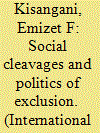

|
|
|
|
|
| Summary/Abstract |
The central African republic(CAR) became independent in August 1960.
|
|
|
|
|
|
|
|
|
|
|
|
|
|
|
|
| 8 |
ID:
111601


|
|
|
|
|
|
|
|